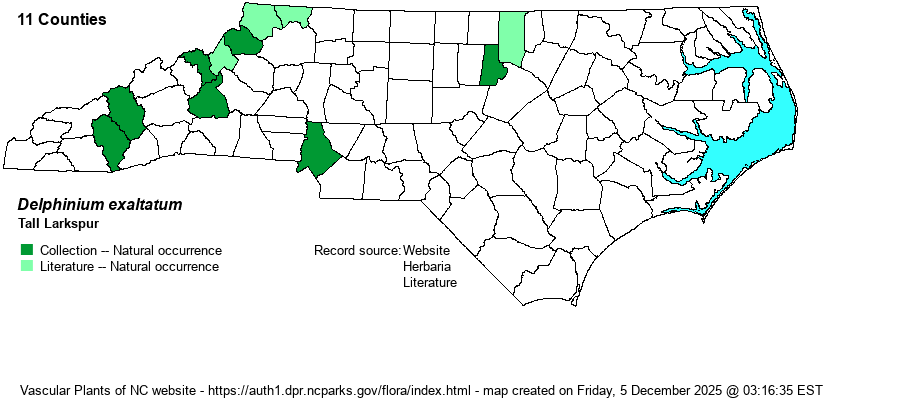| Author | Aiton | |
| Distribution | Very widely scattered in the Mountains, at least as far south as Jackson County; apparently absent in the extreme southwestern tip. A few disjunct records for the Piedmont -- Mecklenburg, Durham, and Granville counties.
This is a globally scarce species of the Mid-Atlantic states and slightly farther west. It ranges north to PA and OH, and south to NC and eastern TN; disjunct to IA and MO. | |
| Abundance | Rare in the northern Mountains, south to Yancey and McDowell counties, and very rare to Jackson County. Extremely rare in the Piedmont, with only a few records. The NCNHP has 16 records, 11 of which are still extant, but two of these (in northeastern Piedmont counties) appear to be (or certainly could be) misidentified records from vegetation plots. It is precariously rare, and the State Threatened status is definitely warranted (though it was listed as State Endangered prior to May 2021). Its State Rank is now S1S2 (as of late 2024). | |
| Habitat | This species requires higher pH (circumneutral) soil in NC, but it is found in a moderate variety of settings. It generally prefers partial sun/shade and somewhat mesic soils as opposed to moist or overly dry. It is best found in open, glade like hardwoods (on ridges), along wooded borders, and in small openings in richer forests. At most sites, one to several other rare plants are found; and any site containing this species should already be protected as a natural area, or be a target for protection. | |
| Phenology | Blooms from July to September, and fruits shortly after flowering. | |
| Identification | This is one of the more spectacular flowering plants in the state, and owing to its great rarity, is a very memorable day to see it in bloom. It is a sturdy/robust herbaceous plant, erect to more often leaning, and reaching 5-6 feet tall. It is a glabrous plant, with some branching in the upper portions. The alternate leaves are widely scattered, with each being strongly dissected into 3 or 5 slender and jagged lobes, each lobe being 2-3 inches long and rather narrow. Several other plants have similar deeply cut/dissected leaves, but few or none on a 5-6-foot-long stem. At the top of the stem, or several branches, is a very long raceme of large blue flowers; the raceme can be 1 foot long or more. The several dozen flowers are not all in bloom at the same time, but each is quite striking, with a long spur extending in the back, and 5 spreading "petals" in "front" -- producing a complex flower about 1 inch long. See website photos to understand the flower shape and structure. If you are lucky enough to find the species, you will certainly be taking photographs, but you should not collect any individuals, as this is a State Threatened species. It is best seen on some of the Amphibolite Mountains in Ashe and Watauga counties. | |
| Taxonomic Comments | None
| |
| Other Common Name(s) | Tall Blue Larkspur | |
| State Rank | S1S2 | |
| Global Rank | G3 | |
| State Status | T | |
| US Status | | |
| USACE-agcp | | |
| USACE-emp | | |

